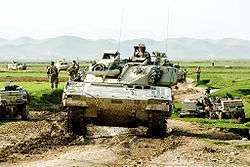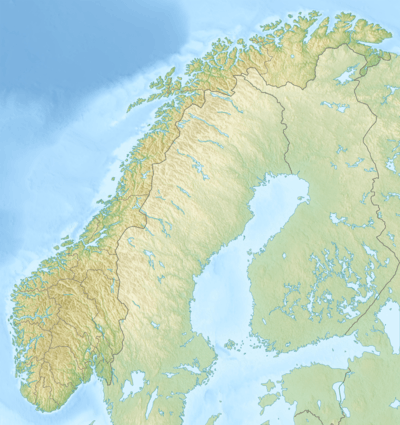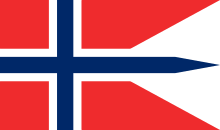Norwegian Army
| Norwegian Army Hæren | |
|---|---|
 | |
| Founded | 1628 |
| Country | Norway |
| Allegiance | King Harald V |
| Branch | Department of Defence |
| Type | Army |
| Size | 11,600 soldiers |
| Motto(s) |
For alt vi har. Og alt vi er. For everything we have. And everything we are. |
| Engagements |
Second Northern War Torstenson War Scanian War Great Northern War Theater War Dano-Swedish War of 1808-1809 Gunboat War Swedish-Norwegian War (1814) World War II Cold War Lebanon War Bosnian War Kosovo War War in Afghanistan War on Terrorism |
| Website |
www |
| Commanders | |
| Commander-in-Chief | King Harald V |
| Minister of Defence | Minister Ine Marie Eriksen Søreide |
| Chief of Defence | ADM Haakon Bruun-Hanssen |
Norway achieved full independence in 1905, and in the first century of its short life has contributed to three major conflicts, World War II, the Cold War and the War on Terror. The Norwegian Army currently operates in Northern Norway and in Afghanistan as well as in Eastern Europe. The Army is the oldest of the service branches, established as a modern military organization in 1628. The Army participated in wars during the 17th, 18th and 19th century as well, both in Norway and abroad.
History
After the Kalmar War broke out in 1611, the Danish king tried to revive the volunteer leidang, with dire results. As the Norwegian citizenry had not been armed or trained in the use of arms for nearly three centuries they were not able to fight. Soldiers deserted or were captured. The soldiers had to participate in military drills, while providing supplementary labor to the local community when not in active service. Although the army still did not represent the whole nation, as city residents were exempt from military duty, 1628 is generally regarded by historians as the year when the modern Norwegian army was born.
During the war of 1643–45, the Norwegian army performed well while its Danish counterpart flopped. As a result, large areas had to be ceded to Sweden. This led the Danish king to invite German mercenaries to coach and command the Danish-Norwegian Armed Forces: a decision echoing down the centuries in traces of Germanic vocabulary used by the Norwegian military to this day. In 2008 the army faced criticism from within for only being able to defend only one district in Oslo in the event of a national invasion.[1]
19th century
In the early 18th century the Swedes invaded Norway again, and this time the Norwegian army held its own, setting the stage for nearly a century of peace – the longest yet in modern Norwegian history – during which time a distinct Norwegian identity began to evolve. German ceased to be the official language of command in the army in 1772, in favor of "Dano-Norwegian". With the outbreak of the Napoleonic wars, Denmark-Norway and Sweden tried to remain neutral; but Denmark's King Fredrik IV's decision to align with Napoleon meant that hostilities reached Norway. By 1807, Denmark-Norway was formally at war with Britain.
As the Napoleonic era drew to a close, the victorious allies decided to award Norway to Sweden in 1814. This union lasted until 1905, during which time the Norwegian Army retained a separate entity within the joint kingdom. Financial budgeting, recruitment, regimental organization and uniforms were all independent of their Swedish counterparts. The basis for recruitment for the Norwegian Army was initially one of conscription for up to five years by lot drawn amongst rural recruits only. A framework was provided by regular soldiers or hvervede, enlisted as long-service volunteers. As with other armies of the period, the payment of a substitute to serve in one's place was permitted. This system was replaced by one of universal conscription introduced in 1854. Enlistment in the active army was however still based on the drawing of ballots, with those escaping full-time service going immediately to the reserve landvern, where they received brief and basic training.
In 1884 the basis of service was further modified with the training period being reduced to 90 days. The regulars of the hvervede were reduced to a cadre of career officers, ncos and other specialists. The individual Norwegian recruit now passed through three stages of service with the line regiments, the militia and the territorial reserve during the 13-year period that his liability for military service lasted. The left-wing parties of the Storting favored the substitution of part-time volunteer rifle clubs for the regular army but this was opposed by the Parliamentary majority on the basis of the doubtful effectiveness of such a force.
In June 1905 the Storting unilaterally dissolved the 91-year-old union with Sweden. After a short but tense period during which both armies were mobilized, Sweden agreed to the peaceful dissolution of the union.
Though nominally a neutral nation during World War I, Norway was in the unenviable position of being dependent on the warring sides for its trade. Coal from Britain was needed to keep the country going, and Norway had thus to agree that each shipload of coal leaving Britain be matched with incoming Norwegian cargoes such as copper ore and fish. This attracted the attention of German submarines.
National militia

By 1920 the army of Norway was a national militia. Service was universal and compulsory, liability commencing at the age of 18 and continuing till the age of 56. The men were called out at 21, and for the first 12 years belonged to the line ; then for 12 years to the landvarn. Afterwards they passed into the landatorm, in which they remained until they attained the age of 55 years. The initial training was carried out in recruits' schools ; it lasted for 48 days in the infantry and garrison artillery, 62 in the mountain batteries, 72 in the engineers, 92 in the field artillery, and 102 in the cavalry. As soon as their courses were finished the men were transferred to the units to which they would permanently belong, and with them went through a further training of 30 days. Subsequent training consisted of 80 days in the second, third and seventh years of service.
The line was organized into 6 divisions of all arms, besides which there was the garrison artillery. There were 56 battalions of infantry, 5 companies of cyclists (skiers), 3 regiments of cavalry (16 squadrons), 27 four-gun field batteries, 3 batteries of mountain artillery, 9 batteries of heavy artillery, and 1 regiment and 2 battalions of engineers. The Flying Corps was organized in 3 divisions. The divisions were of unequal strength, according to the importance of the district in which they were recruited. In event of war, each division would mobilize 2 or 3 regiments of infantry (of 3 battalions), 3 or 4 squadrons of cavalry, a battalion of field artillery (of 3 batteries), a battalion of heavy artillery, a sapper company, a telegraph company, a medical company and a company of train. Each regimental district also forms one battalion of landvarn (of 6 companies), and the other arms would form landvarn units in the same proportion. The total peace strength was 118,500 men and comprised 71,S36 rifles, 228 field and 36 heavy guns. The additional numbers available on mobilization amount to 282,000 men.
The Norwegian infantry was armed with the Norwegian-designed Krag–Jørgensen rifle of 6.5 mm (pictured). The field artillery had Ehrhardt 7.5 cm Model 1901. The budget of the army for 1919–20 was 1,940,000.
20th century
With full Norwegian independence, legislation was passed strengthening the system introduced in 1885. Liability for military service was extended to 55 years of age and the period of training was lengthened to about five months. Additional localized regiments were created within a framework of six military districts, permitting more rapid mobilization of reservists. These precautions proved effective in 1914 with the outbreak of World War I. Norway's armed forces remained mobilized throughout the war, ensuring Norwegian neutrality in conjunction with that of Denmark and Sweden.
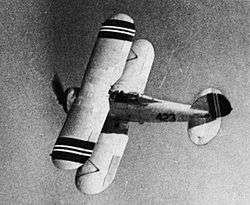
World War II
Despite the escalating hostilities throughout Europe in 1939 and 1940, the Norwegian government at the time failed to mobilize; leaving the Army wholly unprepared for the German invasion of April 1940. With the German occupational forces in 1940, as with the other parts of the Armed Forces, the Army had to surrender to a superior force, but army units were the ones resisting for the longest period of time: The 6th Division led by the legendary Major General Carl Gustav Fleischer participated in the allied recapture of Narvik.
The greatest accomplishment of WW2 by Norwegian forces was the victory in the battle of Narvik, especially the mountain war forcing the German forces all the way from the ocean to the Swedish border. In addition to the Norwegian Campaign, Norwegian soldiers joined the Norwegian resistance movement after German forces occupied Norway. The Home Front (Hjemmefronten) was the Norwegian resistance movement during Nazi Germany's occupation of Norway (1940–1945).
Norwegian soldiers also joined free Norwegian units in the United Kingdom to continue the fight against the Nazis from abroad. These units included the Norwegian Independent Company 1 and 5 Troop, No.10 (Inter Allied) Army Commandos. The bulk of the Norwegian Army during the years in exile in Britain consisted of a brigade in Dumfries as well as smaller units stationed in Iceland, Jan Mayen, Svalbard and South Georgia. The 2nd Mountain Company operated in Finnmark from late 1944 under nominal Russian command. Norwegian police troops and units from this brigade took control over Finnmark in 1944 after the German retreat from the Red Army. Many former Norwegian Army members also served with the German forces.
The Army was reconstructed after the War, based among others on the forces established in exile in Sweden and Great Britain during the War, as well as on domestic forces. The participation in the allied occupation of Germany was a very demanding task for the Army in the period of 1946–52, but it was also a part of the reconstruction. The Army was established in all parts of the country, with a significant stronghold in Troms based on the threat picture of that time: the fear of an invasion from the East. This picture definitely changed with the fall of the Berlin Wall in 1989 and the subsequent break-up of the Soviet Union and the Warsaw Pact. At the end of the Cold War the army could mobilise 13 brigades, although 10 of them were less well equipped.[2] It has been downsized after the end of the Cold War, with the biggest changes taking place in the middle of the 1990s, when a number of garrisons and units were discontinued. This restructuring focused on moving from a fairly static invasion army to a flexible rapid reaction army. The Parliament in 1994 and 1995 approved a series of major organizational changes, for the Army in particular. To ensure a cost-efficient implementation, it is necessary to focus the activities in the Army on the process of transforming the army from a large mobilization army to a smaller, professional army.
The 2005-08 plan envisaged reduction of the then army from three to two brigades, but the essential and key formation was to be Brigade North. The 6 Division Command was to be organised as a mobile tactical headquarters with the capability to serve as a framework for a headquarters for multinational operations above brigade level in Norway. But to keep Brigade North operational Jane's Defence Weekly was told in May 2004 would require two brigade sets of equipment.
21st century
Norwegian contributions to international crisis management have been generated from a system that is first and foremost geared towards the rapid activation of mobilization units armed and trained for territorial defence. As a consequence, Norwegian contributions to international military operations have a high degree of sustainability, as they have a substantial number of reserve units on which to draw. However, without adaptation this force posture is to a lesser extent able to generate forces rapidly and flexibly in response to international crises. Moreover, the contributions that Norway has been able to make to international operations have tended to consist of lightly armoured mechanized infantry, well-suited for more traditional peacekeeping tasks (UNIFIL in southern Lebanon to which Norway contributed a sizable unit for over twenty years) but not sufficiently robust for missions which might entail enforcement tasks.
War in Afghanistan

Norway along with other Scandinavian countries, supported the US War on Terror. The Norwegian government was one of the strongest supporters for the war, Jens Stoltenberg even said "It is also in our interests to hit back against such attacks," but added later "we assume that the USA is not interested in retaliating in any way which could pose a threat to world peace."
| “ | It is also in our interests to hit back against such attacks. | ” | |
| — Jens Stoltenberg | |||
Norwegian Defence Minister at the time, Bjørn Tore Godal, said "the United States is Norway's most important ally. Norway is already providing intelligence assistance to the United States. If we receive a request for further support, including military support, we will of course respond positively, and in accordance with the obligations of article 5 of the NATO treaty."[3]
The Norwegian Army sent troops to support the NATO ISAF mission in Afghanistan, to help free Afghanistan of the Taliban. Norwegian special forces were involved in combat operations during Operation Enduring Freedom in 2002, and Norwegian Army troops during Operation Harekate Yolo in 2007.[4] About 590 Norwegians are serving in the ISAF force.[5]
According to Aftenposten, the Norwegian Army base at Meymaneh was amongst the least secure bases in Afghanistan at one point. Meymaneh is located in northwestern Afghanistan, which has become increasingly restless in recent years. Both the military and political heads of the armed forces agreed about the weakened state of the base. When the Norwegian Army was asked what they needed to defend their position, they asked for 120 troops and long-range weapons. They also requested a mobile reaction force, so that allies in the region could assist each other if they came under heavy attack.[6]
Organization
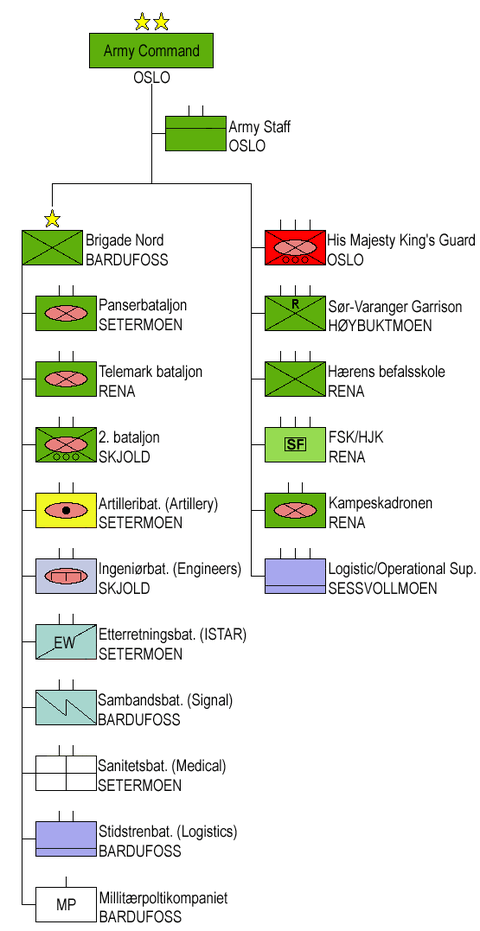
In 2009 the Army introduced the new command and control lines. The General Inspector now commands three subordinate major commands and 5 smaller support units:[7][8]
- Brigade Nord
- Army Weapons School
- Garnisonen i Sør-Varanger
- HM the Kings Guard
- Military Academy
- Logistic and Operational Support
- Army Operations Support
Brigade Nord
The brigade is the Norwegian Army's only major combat formation. Brigade Nord is the northernmost combat brigade in NATO and has the capabilities to plan, lead and implement operations with support from other branches of the Norwegian Defence Forces. The brigade is formed primarily around three all-arms battlegroups:
2012 White Paper
According to the Norwegian MoD 2012 White Paper the Brigade Nord maneuver elements will be reorganised. Telemark Bataljonen and The Armoured Battalion will be organized as two near identical mechanized battalions manned mainly by contract personnel, but with some conscripts. The 2nd Battalion will be developed in the light infantry role, manned mainly by conscript personnel. The brigade will be equipped with organic air defence assets. The reorganization is intended to provide the brigade with 2 continuously combat ready battlegroups.[9]
| Name | Base(s) | About |
|---|---|---|
| Setermoen, Troms | The Armoured Battalion equipped with Leopard 2 tanks and CV-90 infantry fighting vehicles. According to the 2012 White Paper, the battalion will be developed along the lines of Telemark Battalion. | |
| Rena, Hedmark | While the Telemark Battalion currently is fully professional, the 2012 White Paper proposes including some conscripts. The battalion is the Army's rapid reaction force. The battalion is equipped with CV-90 infantry fighting vehicles and Leopard 2 tanks, and can be deployed quickly to deal with national or international crises. | |
| Skjold, Troms | The 2nd Battalion is equipped with lightly armored vehicles. It is mainly based on conscript troops | |
| Setermoen, Troms | The Artillery Battalion provides fire support. | |
| Ingeniørbataljonen | Skjold, Troms | The Engineer Battalion secures the Army's mobility. The battalion also conducts ferry-operations and provides the Army's NRBC defense capability. |
| Setermoen, Troms | The Intelligence Battalion is responsible for the intelligence-support to military operations. Although the unit is part of Brigade Nord, it is capable to support all branches of the Norwegian Defense Forces. | |
| Bardufoss, Troms | The Signals Battalion operates the brigade's communications. | |
| Stridstrenbataljonen | Bardufoss, Troms | The Combat Service and Support battalion is the Army's transportation and supply unit. The battalion also provides maintenance services. |
| Millitærpolitikompaniet | Bardufoss, Troms | The brigade's military police company. |
| Sanitetsbataljonen | Setermoen, Troms | The brigade's medical battalion. |
Structure
Uniforms
Army uniforms consist primarily of a field uniform for use in environments where a durable material is required, a work uniform for use in normal service, usually within and around the camp area, and a binder uniform for use when on leave. There are also specially designed uniforms for personnel in special services.
The army has used the present field uniform {M-75} since 1975. A camouflage pattern version of the field jacket was introduced for use in the peace-time army in 1988. A new uniform M-02, is now also in service.
Ceremonial (galla) uniforms of 19th century origin are worn by the King's Guard, army bands and officers for parade or formal occasions.
Equipment
Ranking system
Before the unit officers was introduced around 1930, in Norway, a system similar to what you have in almost all other countries with two separate career paths:
- A non-commissioned officer who spends most of his career as a section troop commander and second officer, and thus is the leading soldier.
- As the officer who is academically trained, and that previously came from the upper class, who starts his career with a few years as a platoon leader to get some practical experience, but that is focused on command and staff work at higher levels.
Hans Majestets Kongens Garde
The most important task of Hans Majestet Kongens Garde is to protect the King and the royal family in peace, crisis and war. The bases of the battalion is in Oslo and at Terningmoen camp.
Garden is a battalion with high standards in physical fitness, dependability, loyalty, independence, discipline, morale, sense of order, ability to lead themselves in uniform, and the ability to balance their complicated guard duty with relationship to the civilian environment.
In addition to guarding the royal residences all the guards are trained and educated in challenging military combat mission – both as individuals and as part of the Infantry Division. This is to be able to attend His Majesty the King and his family's safety in a modern way in the event of crisis or war.
Garrisons
| Garrisons | Brigades / Companies |
|---|---|
| Jørstadmoen |
FK KKIS(Defence command and control center) CIS TG (Communications and informations systems task group) FIH (Defence engineer school) . FOST (Defence security agency) |
| Huseby Leir |
HMKG ( His Majesty The King's guard) |
| Rena Leir |
Hærens Våpenskole (Army weapons school) Telemark Battalion and attached medical, engineer and logistics companies provided by respective battalions. HJK/Forsvarets Spesialkommando (Army and Joint special forces command) |
| Terningmoen leir |
Hærens Våpenskole (Army weapons school) HMKG school center (His Majesty The King's guard) AFA-Office (Administrative parental department) |
| Sessvollmoen |
FKL (Logistics support center) FMPS (Defence military police school), FSAN (Defence medical center) |
| Skjold | Brigade Nord
Engineer battalion and 2. battalion |
| Setermoen | Brigade Nord
Armor battalion, Intelligence battalion, Medical battalion and Artillery battalion |
| Bardufoss | Brigade Nord
Signals battalion and CSS battalion |
| Porsangermoen | Garrison of Porsanger |
| Høybuktmoen | Garrison of Sør-Varanger |
| Linderud Leir | Military Academy |
References
- ↑ Stian Eisenträger. "- Hæren kan bare forsvare én Oslo-bydel". VG.
- ↑ John Berg, 'High Priority: Country Briefing Norway,' Jane's Defence Weekly, 12 May 2004, p.25.
- ↑ Steve James. "Scandinavian governments support Bush's war against terrorism". World Socialist Web Site. Retrieved 4 October 2001.
- ↑ Vegar Gystad. "Vi har trent for dette lenge". Forsvaret (in Norwegian). Retrieved 15 February 2009.
- ↑ Jonathan Tidsall (24 July 2004). "Norwegian soldier killed in Afghanistan". Aftenposten. Retrieved 15 February 2009.
- ↑ Catherine Stein (5 July 2008). "Norwegian base weakest in Afghanistan". Aftenposten. Retrieved 15 February 2009.
- ↑
- ↑
- ↑ Forsvarsdepartementet. "Et Forsvar for vår tid". White Paper. Regjeringen. Retrieved 22 April 2012.
External links
| Wikimedia Commons has media related to Army of Norway. |



